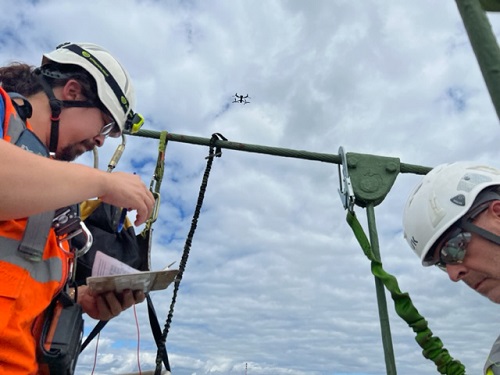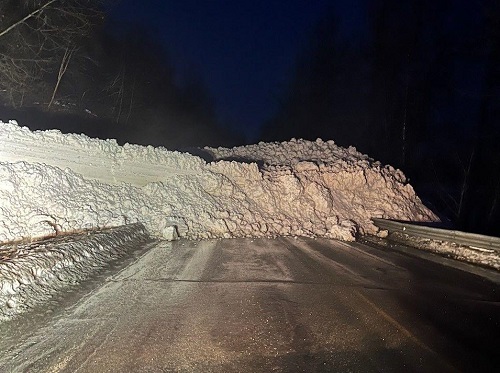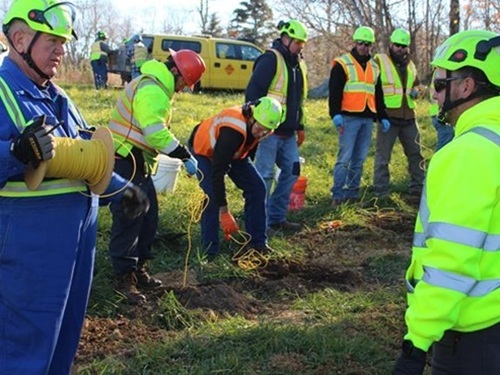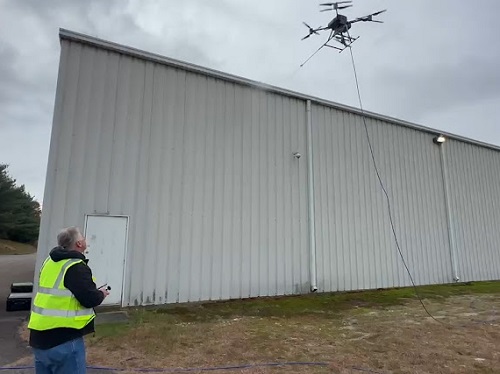A Washington State Department of Transportation Tacoma-area maintenance crew is currently testing drone technology that can remove graffiti from hard-to-reach places; applying paint from aerial positions to cover graffiti on bridge abutments and other types of transportation-related infrastructure.
[Above photo by WSDOT]
In a blog post, WSDOT noted that the drone – built from an Aquiline Endure model – uses a spray nozzle and is linked to a paint supply on the ground. An operator on the ground positions the drone via remote control anywhere the tethered hose can reach, making quick work of painting over graffiti on tall retaining walls, bridges, and overpasses.

WSDOT noted that graffiti removal is part of its maintenance program – the same program that patches potholes, repairs guardrail and culverts, and handles snow and ice response. In 2023, WSDOT said its maintenance crews spent over $815,000 on graffiti removal statewide, including staff time and equipment; equating to nearly 10,300 hours of labor spent covering 700,000 square feet of graffiti along state highways.
But that’s still not enough to remove all the graffiti that appears along the state’s highways, noted Michael Gauger, a WSDOT maintenance superintendent – and it can pose dangers to the crew members doing the graffiti removal work.
Gauger noted in the blog post that the idea for a “graffiti-fighting drone” came to him two years after sending a maintenance team to paint over graffiti on the Capital Boulevard Bridge in Olympia for the second time in two weeks.
He explained it was “frustrating” to pull a bridge maintenance crew from another task, which also required specialized under bridge inspection truck or UBIT so workers could paint over hard-to-reach graffiti. “These trucks are in high demand, and we have six of them to cover the state,” he said. “They are usually reserved for higher-priority bridge maintenance and inspection work.”
That’s when Gauger thought to himself, “There must be a better way to get paint up there.”
It just so happened Gauger was working at the time with the Tacoma Narrows Bridge team using drones for bridge inspections. The drones, equipped with high resolution cameras, were decreasing the number of times crews had to physically inspect underneath the girders. That meant improved employee safety, less time on the inspection and overall cost savings. And if drones could be used for inspections, Gauger thought, why couldn’t they be used to spray paint?
The idea eventually germinated into a WSDOT grant establishing a pilot program to test the feasibility of a graffiti removal drone. Following months of design work, a prototype took flight in early spring for actual field use. WSDOT said it plans to submit a report in December to the state legislature about the “facts and findings” of this graffiti removal drone pilot program for further evaluation; determining whether this technology gets implemented as long-term solution to graffiti removal issues.
State departments of transportation across the country are using drones in a wide variety of capacities.
For example, this spring, the Minnesota Department of Transportation used drones for its “aerial mapping operations” in the northwestern part of the state; using the aerial devices to help create a record of existing infrastructure and landscapes along rights-of-way managed by the agency for transportation planning and highway design.

In February, several state agencies in Alaska collaborated to field test a drone-based avalanche mitigation technology; a system that uses Unmanned Aerial System or UAS craft to place and then remotely trigger explosives to create controlled avalanches in order to protect transportation infrastructure.
The Alaska Department of Transportation & Public Facilities and the Alaska Railroad Corporation used Drone Avalanche Reduction Technology or DART developed by Drone Amplified to place and then detonate explosives; safely setting off avalanches from a distance in order to protect vulnerable transportation infrastructure from damage.
In December 2023, the Federal Aviation Administration issued a wide-ranging drone waiver to the aeronautics division of the Massachusetts Department of Transportation that allows the agency to fly drones over the state’s entire railroad network outside the remote drone operators’ fields of vision.
Known as operating “Beyond Visual Line of Sight” or “BVLOS,” that capability allows MassDOT drones to more efficiently collect data on more than 1,000 miles of rail track when monitoring for impediments such as vegetation encroachment, flooding, or storm damage.
And in August 2023, the Georgia Department of Transportation began participating in a “drone as a first responder” or DFR program along a stretch of I-85.
The goal of that DFR initiative is to eventually enhance safety and emergency response capabilities in the entire West Georgia region; a rural area which hosts multiple key interstate corridors including I-85, I-185, and I-75 that provide critical freight connectivity for major Southeast manufacturing and logistics facilities.
 States
States
NCDOT Staff Participate in ‘Explosive’ Technical Training
December 19, 2025 States
States

